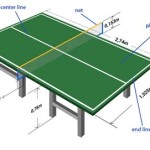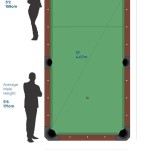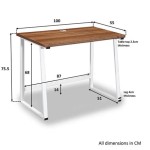How Much Does a Billiard Table Weigh?
Determining the weight of a billiard table is crucial for various reasons, ranging from transportation and installation planning to ensuring the structural integrity of the floor on which it will reside. The weight of a billiard table is a significant factor that prospective buyers, movers, and even homeowners contemplating a game room renovation should carefully consider. Understanding the components contributing to the overall weight and the variations across different table sizes and types is essential for a successful billiard table ownership experience.
The weight of a billiard table is influenced by several key elements. These include the slate bed, the frame, the legs, the rails, and the cloth. Each of these components contributes significantly to the overall mass of the table, making it a substantial and often unwieldy object to move and install. The slate bed, in particular, is the heaviest component and the primary determinant of the table’s overall weight. The quality and thickness of the slate directly impact the playing surface and, consequently, the weight of the billiard table.
Different sizes and types of billiard tables also impact their weight. A 7-foot bar-style table will weigh considerably less than a 9-foot tournament-style table. The materials used in construction, such as solid wood versus particleboard, also play a role. Commercial-grade tables often incorporate heavier, more robust materials for durability, adding to their overall weight. This article will explore these factors in detail, providing a comprehensive overview of billiard table weights and the considerations involved.
Key Point 1: The Slate Bed's Dominant Role in Billiard Table Weight
The slate bed is undoubtedly the heaviest component of a billiard table, accounting for a significant portion of its overall weight. Slate is the preferred material for billiard table beds due to its inherent properties: it is naturally flat, dense, and provides a stable and consistent playing surface. The thickness of the slate directly correlates with the weight of the table. Thicker slate offers improved durability and resistance to warping, but it also adds substantially to the weight.
Billiard table slates typically come in thicknesses ranging from ¾ inch to 1 ½ inches. A ¾ inch slate is commonly found in smaller, less expensive tables, while 1-inch or 1 ¼ inch slate is standard for higher-quality and tournament-grade tables. The thicker 1 ½ inch slate is usually reserved for professional or very high-end residential tables, offering the ultimate in flatness and durability. This difference in thickness directly impacts the weight; a table with 1 ½ inch slate can weigh significantly more than a comparable table with ¾ inch slate.
To illustrate the weight differences, consider a 7-foot billiard table. A 7-foot table with ¾ inch slate might weigh around 450 to 600 pounds. A similar 7-foot table with 1-inch slate could weigh between 600 and 750 pounds. The increase in weight is directly proportional to the added thickness and density of the slate. For larger tables, such as a 9-foot model, the weight difference becomes even more significant. A 9-foot table with 1-inch slate could easily weigh between 800 and 1,000 pounds, while a 9-foot table with 1 ¼ inch slate could exceed 1,000 pounds.
Beyond the thickness, the slate is often divided into multiple pieces, typically three, for easier handling and installation. These pieces are carefully leveled and joined together to create a seamless playing surface. While the division into multiple pieces facilitates transportation and installation, the overall weight of the slate remains the primary determinant of the table's total mass.
Therefore, understanding the slate's thickness and corresponding weight is paramount when planning for the transportation, installation, and placement of a billiard table. Failing to account for the weight of the slate can lead to logistical challenges and potential structural concerns regarding the floor's load-bearing capacity.
Key Point 2: The Impact of Table Size and Construction Materials
Besides the slate bed, the size of the billiard table and the materials used in its construction significantly influence its weight. Billiard tables are commonly available in sizes ranging from 6 feet to 9 feet, with 7-foot and 8-foot tables being popular choices for residential use. The larger the table, the more material is required for the frame, legs, and rails, resulting in a heavier overall weight.
A 6-foot billiard table, often referred to as a "bar table," is the smallest standard size and typically weighs between 350 and 500 pounds. These tables usually feature thinner slate and less substantial frames compared to larger models. A 7-foot table, a common size for home game rooms, generally weighs between 450 and 750 pounds, depending on the slate thickness and construction materials. An 8-foot table, a preferred size for many serious players, can weigh anywhere from 600 to 900 pounds. Finally, a 9-foot table, the size used in professional tournaments, typically weighs between 800 and 1,200 pounds or more.
The materials used in the table's construction also play a significant role. Solid hardwood frames, such as oak or maple, are heavier and more durable than frames constructed from particleboard or plywood. High-quality tables often feature solid wood legs and rails, adding to the overall weight and stability. Cheaper tables may use less dense materials, resulting in a lighter weight but potentially compromising durability and longevity.
Furthermore, the design and complexity of the table can also affect the weight. Tables with intricate carvings, elaborate leg designs, or additional features, such as ball return systems, will generally weigh more than simpler, more minimalist designs. Commercial-grade tables, designed for heavy use in bars and pool halls, are typically built with heavier materials and reinforced frames to withstand constant play, resulting in a substantial increase in weight compared to residential models.
Therefore, when considering the weight of a billiard table, it is important to factor in both the table's size and the materials used in its construction. Opting for a larger table or one constructed with solid hardwood will inevitably result in a heavier table, requiring careful consideration of transportation, installation, and floor load-bearing capacity.
Key Point 3: Considerations for Transportation, Installation, and Floor Support
Understanding the weight of a billiard table is paramount when planning for its transportation, installation, and ensuring adequate floor support. Billiard tables are heavy and unwieldy objects, requiring specialized equipment and experienced movers to handle them safely and efficiently. Attempting to move a billiard table without the proper tools and expertise can result in damage to the table, injury to the movers, and potential damage to the property.
When transporting a billiard table, it is essential to disassemble it into its component parts, including the slate bed, frame, legs, and rails. The slate, being the heaviest component, should be handled with extreme care. Professional movers typically use specialized dollies and lifting equipment to transport the slate safely. The frame and legs can be moved separately, but it is important to protect them from scratches and dents during transport.
Installation of a billiard table is a complex process that requires precise leveling and alignment. The slate pieces must be carefully joined together to create a seamless playing surface, and the frame and legs must be securely attached to provide a stable base. This process often requires specialized tools and expertise to ensure that the table is perfectly level and plays accurately.
Before installing a billiard table, it is crucial to assess the floor's load-bearing capacity. Billiard tables are heavy, and their weight is concentrated on a relatively small area. If the floor is not strong enough to support the weight of the table, it could lead to structural damage, such as sagging or cracking. In some cases, it may be necessary to reinforce the floor before installing a billiard table, particularly in older homes or those with wooden subfloors.
For instance, a 9-foot billiard table weighing over 1,000 pounds exerts significant pressure on the floor. This weight is distributed over the legs, typically six or eight, concentrating the load in those specific areas. If the floor joists are not adequately sized or spaced, they may deflect or even fail under the weight. Consult with a structural engineer or contractor to evaluate the floor's capacity and recommend appropriate reinforcement measures if necessary.
In conclusion, the weight of a billiard table is a critical consideration for transportation, installation, and floor support. Proper planning and preparation are essential to ensure a safe and successful billiard table ownership experience. Engaging experienced movers and installers and assessing the floor's load-bearing capacity are crucial steps in the process.

How Much Does A Pool Table Weigh Weight Of Slate

How Heavy Is A Pool Table Home Leisure Direct Advice

Average Pool Table Weight For All Sizes And Types Thinking Of A Then You Need To Know What It S Going Weigh

How Heavy Is A Pool Table Home Leisure Direct Advice

How Heavy Is A Pool Table Home Leisure Direct Advice

How Much Does A Pool Table Weigh Weight Of Slate

Pool Table Weight Everything You Wanted To Know Home Billiards S

How Much Does A Pool Table Weigh Weight Of Slate

Pool Table Q A How Much Does Weigh

How Much Does A Pool Table Weigh Weight Of Slate








